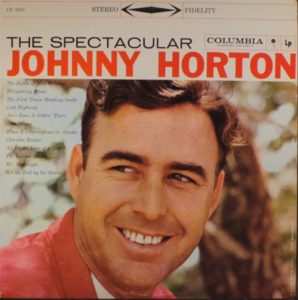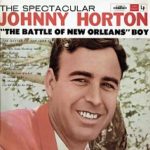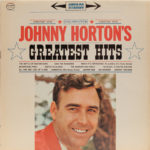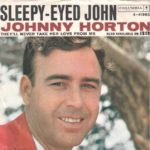I discovered Horton as a kid in the 70s through the film 1960 film “North to Alaska” … it was and still is one of my favourite John Wayne films and the theme song by Horton is incredible catchy and had me singing it all over the place. I wasn’t the only one, as evidenced by its popularity ((#2 Australia, #23 UK, #1 US country, #4 US pop, #10 US R&B!)
That was Horton’s peak.
The final of three #1 one country singles (or one #1 and two Top 10 Pop singles) in the US.
He was dead by years end.
Horton was born in Los Angeles in 1925, the son of sharecropping parents. During his childhood, his family continually moved between California and Texas, in an attempt to find work. His mother taught him how to play guitar at the age of 11. Horton graduated from high school in 1944 and attended a Methodist seminary with the intent of joining a ministry. After a short while, he left the seminary and began traveling across the country, eventually moving to Alaska in 1949 to become a fisherman. While he was in Alaska, he began writing songs in earnest. https://www.allmusic.com/artist/johnny-horton-mn0000198783/biography
He moved to Southern California and was billed as "The Singing Fisherman."
The following year, Horton moved back to east Texas, where he entered a talent contest hosted by Jim Reeves, who was then an unknown vocalist. He won the contest, which encouraged him to pursue a career as a performer. https://www.allmusic.com/artist/johnny-horton-mn0000198783/biography
Hits followed including pop supremacy after the back-to-back country number one successes of "When It's Spring Time in Alaska" and "The Battle of New Orleans," in 1959
Around the time of "North to Alaska's” November release, Horton claimed that he was getting premonitions of an early death. Sadly, his premonitions came true. On November 4, 1960, he suffered a car crash driving home to Shreveport after a concert in Austin, TX. Horton was still alive after the wreck, but he died on the way to the hospital; the other passengers in his car had severe injuries, but they survived”.
https://www.allmusic.com/artist/johnny-horton-mn0000198783/biography
Horton had been recording and releasing music since 1952 but this was his first album proper.
For music collectors and completists he had, actually, recorded an album earlier …
In early 1958 he was so desperate for some dollars that he went into the studios of KWKH in Shreveport (where he had worked on the Louisiana Hayride) to record ten tracks for SESAC, the performing rights society. There was no chance of sales on this music as the songs were to be used as adverts for his live shows (after Horton's death, Columbia records purchased the SESAC masters, added two tracks and issued them as the LP "I Can't Forget You" in 1965).
His was an old school country singer who adapted his style and introduced elements of honky tonk country, trad country and rockabilly (having, apparently, been impressed with the success his label mate Elvis was having with the crowds at the Louisiana Hayride).
He had some success, three top 10s and a Top 20 in 1956-57 but the hits dried up more or less – there was a another top 10 country US in 1958 and then he hit the crossover bigtime.
He incorporated elements of pop and country folk storytelling into his sounds.
The style had been popular throughout the 1950s being used in western film themes by Frankie Laine, Guy Mitchell, Tennessee Ernie Ford, Tex Ritter and others.
The theme songs, inevitably, described and complimented the film narrative.
Horton took it to the next level and applied the sound to describing historical incidents.
Sometimes called saga songs (or historical saga songs) these songs taught history through music, though admittedly, the history can be a bit loose.
This was incredibly popular, the regional edges of country music were smoothed down though the songs retained their country bounce. He became a kind of, soft honky tonk Jim Reeves, who was likewise very crossover popular at the time.
His methodology of storyteller with a point was very influential especially on Johnny Cash (who was a close friend) who later recorded many similar songs, Jimmy Dean, Tom T Hall, Robbins and others.
Horton never abandoned his earlier sounds and mixed them up with the storytelling.
His voice is clear and authoritative with a country accent but not an overwhelming one (as you would expect from someone brought up in California and Texas) and he has a straightforward energetic (though occasionally almost deadpan) singing voice, perfect for dispensing history (through music). The joy comes in the lack of vocal emotional dramatics and the pop bounce in his music.
This album has country love songs and country cheatin' songs, ramblin' blues, murder ballads, historical songs and some rockabilly with nods to pop and the Nashville Sound. It, pretty much, sums up country music at the end of the 1950s.
Ultimately, as fun as his albums are he remained a singles artist. His storytelling had to hit the right song with the right story to be told, or the right film to tie into (ie: “North to Alaska”, “Sink the Bismarck” (inspired by – and commissioned by the film studio), and even the subject matter of the song "The Battle of New Orleans" was the subject of the big budget 1958 film "The Buccaneer")
Tracks (best in italics)
Side One
- The Battle of New Orleans – (Jimmie Driftwood) – The song describes the War of 1812 and the Battle of New Orleans against the British, from the perspective of an American soldier. The song is light in tone and slightly comical. Wonderful. https://en.wikipedia.org/wiki/The_Battle_of_New_Orleans
- Whispering Pines – (Howard Hausey) – First done by Johnny. A ballad done in the smooth "Nashville sound" sound, and quite evocative.
- The First Train Headin' South – (Johnny Horton) – a good rocker that was a good indication of his rockabilly leaning.
- Lost Highway – (Leon Payne) – written and released by legendary country singer songwriter Leon Payne in 1948 it has become identified with Hank Williams who released it in 1949. A good version. https://en.wikipedia.org/wiki/Lost_Highway_(Leon_Payne_song)
- Joe's Been A-Gittin' There – (Grady Martin / Marijohn Wilkin) – first sung my Johnny. A story song, but not about anybody famous, I think. Sorry Joe.
- Sam Magee – (Jimmie Driftwood) – another story song written about a rugged Klondike frontier type, by school teacher singer Jimmy Driftwood.
Side Two
- When It's Springtime in Alaska (It's Forty Below) – (Tillman Franks / Johnny Horton) – country tragedy. https://en.wikipedia.org/wiki/When_It%27s_Springtime_in_Alaska_(It%27s_Forty_Below)
- Cherokee Boogie – (Moon Mullican) – Moon Mullican's #7 US Country hit from 1951. Hillbilly boogie. Great, un-PC with a great rockabilly type beat with Gene Vincent Bluecaps hand claps.
- All for the Love of a Girl – (Johnny Horton) – the usual country love song with a nice, slightly otherworldly feel. Covered by Marty Robbins, Jim & Jesse and Robert Gordon and others.
- The Golden Rocket – (Hank Snow) – released by Hank Snow in 1950 (#1 US Country) . Hank is clearly an influence on Johnny’s style. This is a train song. Country music and train songs … very natural. https://en.wikipedia.org/wiki/The_Golden_Rocket
- Mr. Moonlight – (Ray Griff) – First recorded by Johnny. Canadian singer and songwriter, Griff, was 17 years old (or thereabouts) and subsequently toured with Johnny. Pretty good
- Got the Bull by the Horns – (Amos Boyd / Billy Jones) – first recorded by Johnny. A great honky tonk country (with pop asides) tune. Some Jordanaires type backing. Perfect.
And …
A hoot … perfect for BBQs or smokin' cookouts. I'm keeping it.
Chart Action
US
Singles
1959 When It's Springtime in Alaska (It's Forty Below) #1US Country
1959 The Battle Of New Orleans #1 US Pop, #1 US Country
Album
—
England
Singles
1959 The Battle Of New Orleans #16
Album
—
Sounds
The Battle of New Orleans
live
https://www.youtube.com/watch?v=mjXM6x_0KZk
the British version (covering all markets)( This oddity was intended for British audiences, after the BBC banned the original song)
https://www.youtube.com/watch?v=rWVypBROMgQ
mp3 attached
Whispering Pines
https://www.youtube.com/watch?v=_XnhL4DPebE
The First Train Heading South
mp3 attached
Lost Highway
https://www.youtube.com/watch?v=bM97v-D2tn4
Sam Magee
https://www.youtube.com/watch?v=eM0-eeOEwhI
When It's Springtime In Alaska
Live
https://www.youtube.com/watch?v=VKvJm2ROX_8
Cherokee Boogie
https://www.youtube.com/watch?v=D0Vqh3MP3BA
The Golden Rocket
https://www.youtube.com/watch?v=rZH4IFfWcIM
Got The Bull By The Horns
https://www.youtube.com/watch?v=EArPVHtQ5wc
Others
https://www.youtube.com/watch?v=skbFnKkBgRA
https://www.youtube.com/watch?v=nAbZ3I6-1lY
https://www.youtube.com/watch?v=wgw8UYAxMgY
concert
https://www.youtube.com/watch?v=ow_Dk4E33X4
https://www.youtube.com/watch?v=a8axcGYOFfo
Review
https://www.allmusic.com/album/the-spectacular-johnny-horton-mw0000609325
http://countrystandardtime.com/d/cdreview.asp?xid=1473
Bio
http://www.rockabillyhall.com/JohnnyHorton1.html
https://www.allmusic.com/artist/johnny-horton-mn0000198783/biography
https://en.wikipedia.org/wiki/Johnny_Horton
https://www.findagrave.com/memorial/1990
https://en.wikipedia.org/wiki/Jimmy_Driftwood
Website
—
Trivia
- Horton married Hank Williams widow, Billie Jean Williams, in 1953. Horton's early his tenure on the Louisiana Hayride barn dance show in Shreveport, La is where he met and was briefly mentored by Hank Williams)
- The accident, “Tommy Tomlinson flew in from Nashville where he was cutting a duet album with Jerry Kennedy (Tom and Jerry). Johnny used the morning to make arrangements to go duck hunting with Claude King once he'd returned from Austin and he also phoned Johnny Cash for a chat. Cash was stoned and didn't take the call, and has always regretted it. That afternoon, as he went to collect Franks, he kissed Billie Jean goodbye in the same spot Hank had done seven years earlier, and cuddled his two daughters. Against his wife's wishes, Franks got out off his sick bed and off they headed for Austin … When they got to the Skyline, Horton stayed in his dressing room, convinced that a drunk would kill him if he hung around the bar. After the show, they started the 220 mile journey back to Shreveport. Tomlinson was in the back, observing that Horton was driving too fast – Franks was asleep in the front. About 2am, near Milano, Texas they were crossing a bridge when a truck came at them, hitting both sides of the bridge before plunging into Horton's Cadillac. He had practised avoiding head-on collisions, by driving into verges, but on the narrow bridge he'd had no opportunity. He was still breathing when he was pulled out of the Caddie but died on the way to hospital. The nineteen year old truck driver, James Davis was intoxicated. Johnny Horton had died at the hands of a drunk. It is believed that a sun visor rod had pierced his skull. Franks suffered head injuries and young Tomlinson had multiple leg fractures and nine months later, had to have his left leg amputated. Ironically, Davis was virtually unscathed”. http://www.rockabillyhall.com/JohnnyHorton1.html
- When Johnny Cash, a good friend of Horton's, learned about the accident he said, "[I] locked myself in one of the hotel's barrooms and cried." Cash dedicated his rendition of "When It's Springtime in Alaska (It's Forty Below)" to Horton on his album Personal File: "Johnny Horton was a good old friend of mine." https://en.wikipedia.org/wiki/Johnny_Horton
- The Australian release of this album (and the one I have) is on Coronet records and has a slightly different cover picture. It seems to be from the same sessions but Johnny is looking at the camera on this release, which is similar and different to his Sleepy-Eyed John 45 sleeve from 1963, and his Greatest Hits from 1961.




